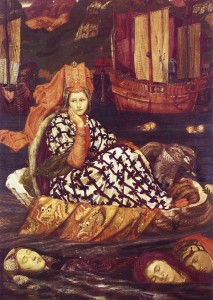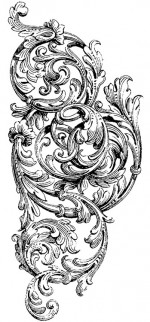 In honor of the holiday, I thought I’d talk a little about things I’m thankful for—yes, I’m thankful for my family, friends, and students, but today I’m going to talk about a few books for which I give thanks.
In honor of the holiday, I thought I’d talk a little about things I’m thankful for—yes, I’m thankful for my family, friends, and students, but today I’m going to talk about a few books for which I give thanks.
But how to narrow down this list to something that wouldn’t make people’s eyes glaze over (my initial “short” list was nearly thirty books long)? I decided to focus on a semi-random selection of the books that either I reread regularly (and I’m not a big re-reader, I confess) or that had a big impact on me the first time I read them. Probably another similar post will be needed before I cover all the books for which I really give thanks. Maybe a couple of similar posts. Warning: Spoilers to follow.
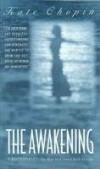 The Awakening by Kate Chopin. If asked to name a favorite book, I always choose between The Awakening and The Master and Margarita. I didn’t read The Awakening until I was in college, and I was profoundly struck by this short novel and continue to be struck by it each time I reread it. People will no doubt find the following statement strange, but I connect and identify with Edna so much that I can’t really articulate the degree to which I feel that connection. Yes, she’s profoundly selfish and naive and immature—which perhaps I am as well—but what speaks to me about Edna’s character is this awakened hunger for and struggle with her identity (both artistic and sexual), which comes long after women of her time would have made their choices. Besides Edna, why I am thankful for The Awakening has a lot to do with Chopin’s structure of the novel, which is so perfect, and so perfectly aware of what it’s doing, that I fall in love with it over and over again.
The Awakening by Kate Chopin. If asked to name a favorite book, I always choose between The Awakening and The Master and Margarita. I didn’t read The Awakening until I was in college, and I was profoundly struck by this short novel and continue to be struck by it each time I reread it. People will no doubt find the following statement strange, but I connect and identify with Edna so much that I can’t really articulate the degree to which I feel that connection. Yes, she’s profoundly selfish and naive and immature—which perhaps I am as well—but what speaks to me about Edna’s character is this awakened hunger for and struggle with her identity (both artistic and sexual), which comes long after women of her time would have made their choices. Besides Edna, why I am thankful for The Awakening has a lot to do with Chopin’s structure of the novel, which is so perfect, and so perfectly aware of what it’s doing, that I fall in love with it over and over again.
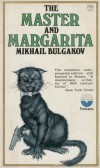 The Master and Margarita by Mikhail Bulgakov. I also discovered this novel in a college class, and Bulgakov made me fall in love with Russia. The satire—of which I don’t read a great deal—has always spoken to me (Woland’s retinue is hilarious), as has the masterful way Bulgakov merges what seems to be, until half-way through the book, three separate storylines (again, a structural marvel). “Manuscripts don’t burn,” Woland tells the Master, a writer, and I connected to the notion that even in such a repressive atmosphere as Stalinist Russia people believed, had to believe, in the endurable nature of art and ideas. Also, how Bulgakov managed to make Pontius Pilate sympathetic and interesting and tragic all at once is no mean feat, either. Plus I was always a sucker for witches and ill-fated romance. Really, we might as well call The Master and Margarita a kitchen-sink novel for all that Bulgakov tosses in and melds so perfectly.
The Master and Margarita by Mikhail Bulgakov. I also discovered this novel in a college class, and Bulgakov made me fall in love with Russia. The satire—of which I don’t read a great deal—has always spoken to me (Woland’s retinue is hilarious), as has the masterful way Bulgakov merges what seems to be, until half-way through the book, three separate storylines (again, a structural marvel). “Manuscripts don’t burn,” Woland tells the Master, a writer, and I connected to the notion that even in such a repressive atmosphere as Stalinist Russia people believed, had to believe, in the endurable nature of art and ideas. Also, how Bulgakov managed to make Pontius Pilate sympathetic and interesting and tragic all at once is no mean feat, either. Plus I was always a sucker for witches and ill-fated romance. Really, we might as well call The Master and Margarita a kitchen-sink novel for all that Bulgakov tosses in and melds so perfectly.
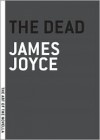 “The Dead” by James Joyce is a novella, not technically a book, I know, but since it is often published on its own, I figured I could get away with including it on this list on a technicality. My first experience with this piece was actually the film adaptation by John Huston, which I think is exquisite, but after reading the ending of the novella below, how could anyone not be thankful for “The Dead”?
“The Dead” by James Joyce is a novella, not technically a book, I know, but since it is often published on its own, I figured I could get away with including it on this list on a technicality. My first experience with this piece was actually the film adaptation by John Huston, which I think is exquisite, but after reading the ending of the novella below, how could anyone not be thankful for “The Dead”?
A few light taps upon the pane made him turn to the window. It had begun to snow again. He watched sleepily the flakes, silver and dark, falling obliquely against the lamplight. The time had come for him to set out on his journey westward. Yes, the newspapers were right: snow was general all over Ireland. It was falling on every part of the dark central plain, on the treeless hills, falling softly upon the Bog of Allen and, farther westward, softly falling into the dark mutinous Shannon waves. It was falling, too, upon every part of the lonely churchyard on the hill where Michael Furey lay buried. It lay thickly drifted on the crooked crosses and headstones, on the spears of the little gate, on the barren thorns. His soul swooned slowly as he heard the snow falling faintly through the universe and faintly falling, like the descent of their last end, upon all the living and dead. (63-64)
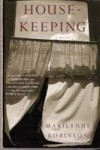 Housekeeping by Marilynne Robinson. Where to begin with this novel that is so beautifully and so vividly written? The third book on this list I discovered through a college class, Housekeeping may be one of the most beautiful books I’ve ever read. The course I read it in was the Senior Seminar for English majors, in a section called “The Sororal Quest” (we also read Little Women, which I didn’t like nearly as much as Housekeeping). I offer this testament to the power of her writing: for years after I saw the film version, directed by Bill Forsyth, I thought the train crash scene had been part of the movie, but the image I had so firmly embedded in my memory was based on Robinson’s words alone.
Housekeeping by Marilynne Robinson. Where to begin with this novel that is so beautifully and so vividly written? The third book on this list I discovered through a college class, Housekeeping may be one of the most beautiful books I’ve ever read. The course I read it in was the Senior Seminar for English majors, in a section called “The Sororal Quest” (we also read Little Women, which I didn’t like nearly as much as Housekeeping). I offer this testament to the power of her writing: for years after I saw the film version, directed by Bill Forsyth, I thought the train crash scene had been part of the movie, but the image I had so firmly embedded in my memory was based on Robinson’s words alone.
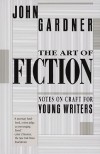 The Art of Fiction: Notes on Craft for Young Writers by John Gardner. One of the best books I’ve read about writing ever, I couldn’t not include The Art of Fiction on this list. When I read this book in my twenties, I had already read, and loved, Gardner’s Grendel, his reworking of the Beowulf story, which was already dear to my heart. One of the things I appreciated most about The Art of Fiction is that Gardner took the art of writing so seriously, that he had absolute ideas about writing (even if I didn’t agree with him, I was taken by his conviction), and that he took the fantastic seriously as an option for a writer (he himself wrote several works in the fabulist vein). He is oft quoted for saying that “fiction does its work by creating a dream in the reader’s mind” and “that if the effect of the dream is to be powerful, the dream must probably be vivid and continuous” (31).
The Art of Fiction: Notes on Craft for Young Writers by John Gardner. One of the best books I’ve read about writing ever, I couldn’t not include The Art of Fiction on this list. When I read this book in my twenties, I had already read, and loved, Gardner’s Grendel, his reworking of the Beowulf story, which was already dear to my heart. One of the things I appreciated most about The Art of Fiction is that Gardner took the art of writing so seriously, that he had absolute ideas about writing (even if I didn’t agree with him, I was taken by his conviction), and that he took the fantastic seriously as an option for a writer (he himself wrote several works in the fabulist vein). He is oft quoted for saying that “fiction does its work by creating a dream in the reader’s mind” and “that if the effect of the dream is to be powerful, the dream must probably be vivid and continuous” (31).
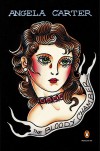 The Bloody Chamber and Other Stories by Angela Carter. Even though I had seen the film The Company of Wolves at least ten years earlier, I came to this book later than I would have liked (my mid-twenties), especially aggrieving considering how central it is to contemporary fairy-tale adaptation. Carter’s writing is sensual and sharp and playful, and the way she plays with the original fairy tales is likewise sensual and sharp. My favorite story in the collection is “The Company of Wolves,” wherein she (re)introduces the idea of Little Red Riding Hood’s wolf as a werewolf as well as merging the wolf and the Grimms’ helpful huntsman. No one is to be trusted! But our heroine still saves herself, neat as you please. Other favorite stories include “The Bloody Chamber,” a retelling of “Bluebeard” where the hapless heroine is rescued by her kick-ass mother, and the two reworkings of Beauty & the Beast: “The Courtship of Mr. Lyon” and “The Tiger’s Bride.”
The Bloody Chamber and Other Stories by Angela Carter. Even though I had seen the film The Company of Wolves at least ten years earlier, I came to this book later than I would have liked (my mid-twenties), especially aggrieving considering how central it is to contemporary fairy-tale adaptation. Carter’s writing is sensual and sharp and playful, and the way she plays with the original fairy tales is likewise sensual and sharp. My favorite story in the collection is “The Company of Wolves,” wherein she (re)introduces the idea of Little Red Riding Hood’s wolf as a werewolf as well as merging the wolf and the Grimms’ helpful huntsman. No one is to be trusted! But our heroine still saves herself, neat as you please. Other favorite stories include “The Bloody Chamber,” a retelling of “Bluebeard” where the hapless heroine is rescued by her kick-ass mother, and the two reworkings of Beauty & the Beast: “The Courtship of Mr. Lyon” and “The Tiger’s Bride.”
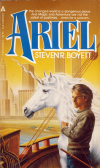 Ariel by Steven R. Boyett. I reread Ariel several times in high school and in college, but I don’t know if I read it for the first time now that I would feel as passionately about this post-apocalyptic novel of a boy and his unicorn. Still, a part of my teenage heart will always belong to this novel. The pretty amazing thing was that Boyett started writing this book when he was a freshman in college, and then a couple years later he published it. Surely, the teenage writer in me was inspired by this back story. The world Boyett created spoke to me, and Ariel was one of the books that moved me away from writing secondary-world fantasy as well as showing me how well a first-person narrator can work (also, Ariel got me hooked on epigraphs, which I used everywhere—I even got a reputation in college for using epigraphs on my academic essays, as I’m pretty sure every essay I submitted to an upper-level English course had one).
Ariel by Steven R. Boyett. I reread Ariel several times in high school and in college, but I don’t know if I read it for the first time now that I would feel as passionately about this post-apocalyptic novel of a boy and his unicorn. Still, a part of my teenage heart will always belong to this novel. The pretty amazing thing was that Boyett started writing this book when he was a freshman in college, and then a couple years later he published it. Surely, the teenage writer in me was inspired by this back story. The world Boyett created spoke to me, and Ariel was one of the books that moved me away from writing secondary-world fantasy as well as showing me how well a first-person narrator can work (also, Ariel got me hooked on epigraphs, which I used everywhere—I even got a reputation in college for using epigraphs on my academic essays, as I’m pretty sure every essay I submitted to an upper-level English course had one).
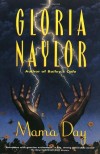 Mama Day by Gloria Naylor. For a long time, I taught Mama Day in any number of classes—freshman composition, Magic Realism, 20th-Century Fantasy in Literature & Film—and it’s a book I think really pops on the page. Naylor creates such a vivid characters (including the island, Willow Springs), and I love what she does with point of view here. The narrative alternates between Cocoa’s and George’s points of view, along with a third-person, fairly omniscient p.o.v. As the titular character says, “Just like that chicken coop, everything got four sides: his side, her side, an outside, an inside. And all of it is the truth” (230).
Mama Day by Gloria Naylor. For a long time, I taught Mama Day in any number of classes—freshman composition, Magic Realism, 20th-Century Fantasy in Literature & Film—and it’s a book I think really pops on the page. Naylor creates such a vivid characters (including the island, Willow Springs), and I love what she does with point of view here. The narrative alternates between Cocoa’s and George’s points of view, along with a third-person, fairly omniscient p.o.v. As the titular character says, “Just like that chicken coop, everything got four sides: his side, her side, an outside, an inside. And all of it is the truth” (230).
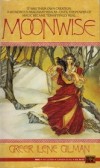 Moonwise by Greer Gilman was published during my last year of college, and I remember being caught by the Tom Canty cover (one of my favorite artists). The back copy intrigued me, so I bought Moonwise. When I started to read it, I had to stop and then start over, reading it aloud. Gilman’s use of language is so artful and dense that this novel might as well be described as a prose-poem. I was intrigued by the story, by the magic, by the mythos, but it’s the language that still strikes at my heart. Here’s a sample:
Moonwise by Greer Gilman was published during my last year of college, and I remember being caught by the Tom Canty cover (one of my favorite artists). The back copy intrigued me, so I bought Moonwise. When I started to read it, I had to stop and then start over, reading it aloud. Gilman’s use of language is so artful and dense that this novel might as well be described as a prose-poem. I was intrigued by the story, by the magic, by the mythos, but it’s the language that still strikes at my heart. Here’s a sample:
There was a green bough hanging on the door. The year was old, and turning lightward, into winter. Cold and waning, at the end of her long journey, Ariane looked back the way she’d come. Bare woods, bright wind that shook the rain from naked trees, a stony slant of field: the earth lay thinly here. The trees stood lightstruck, hill beyond blue glaze of hill. Then it darkened again, turned cloud and clods of earth, and crow-blotched trees: a drizzling thaw. (3)

